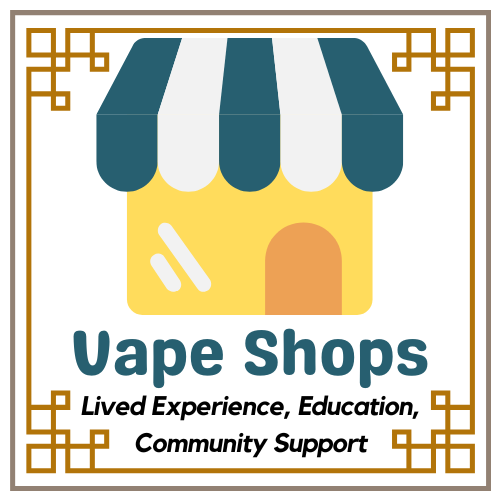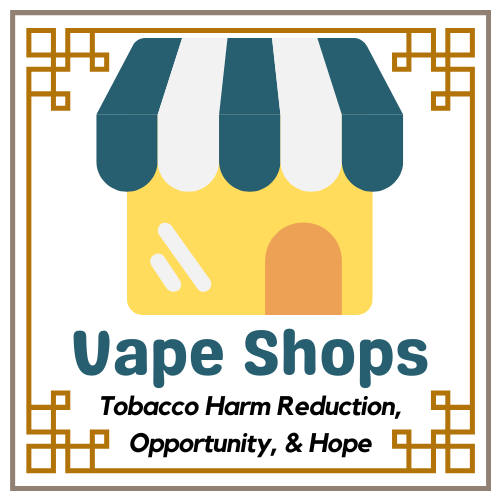ENDS Vape Shops: Difference between revisions
Jump to navigation
Jump to search
No edit summary |
(graphics) |
||
| Line 3: | Line 3: | ||
<br> | <br> | ||
[[file:Vape Shops.png|left]] | [[file:Vape Shops.png|left]] | ||
[[file: | [[file:Yellow Flat Store Logo 2.png|left]] | ||
=Community= | =Community= | ||
=Economic Information= | =Economic Information= | ||
| Line 14: | Line 14: | ||
<br> | <br> | ||
=Regulations= | =Regulations= | ||
| Line 84: | Line 83: | ||
*Mod use and intention to use e-cigs as a cessation device were significantly associated with vape shop spending. | *Mod use and intention to use e-cigs as a cessation device were significantly associated with vape shop spending. | ||
*Customers who spent more than $50/month used lower levels of nicotine (mg/ml) (p=0.003) but a greater quantity of e-liquid (ml/month). | *Customers who spent more than $50/month used lower levels of nicotine (mg/ml) (p=0.003) but a greater quantity of e-liquid (ml/month). | ||
<br> | <br> | ||
| Line 137: | Line 125: | ||
*Senator Ron Johnson to President Trump | *Senator Ron Johnson to President Trump | ||
<br> | <br> | ||
=Tools for shops: Age Verification= | |||
=Tools for shops: Recycling= | |||
=Tools for shops: Training Programs For Shop Staff= | |||
===[https://squiral.net/home SQUIRAL]=== | |||
*The course is called SQUIRAL ('''S'''upporting '''Q'''uitting: '''U'''nderstanding the theory of addiction & '''I'''ncreasing knowledge of '''R'''eplacements & remedies. '''A'''n on'''L'''ine course). <nowiki>https://squiral.net/home</nowiki> | |||
*It has been designed for adults over the age of 21 who currently work as: | |||
** LMIC (low and low-middle income country) Community Health Workers | |||
** Indigenous community health workers; or | |||
** Vape shop staff or other retailers of THR products. | |||
*The course may also be useful for THR advocates who regularly advise people who smoke to switch to THR alternatives. | |||
<br> | |||
=Suggestions to add to this page= | =Suggestions to add to this page= | ||
Revision as of 10:43, 26 June 2022


Community
Economic Information
2019: The Vapor industry Economic Impact Study
- The vapor industry is a dynamic part of the U.S. economy, accounting for about $24.46 billion in output or about 0.14 percent of GDP. It employs approximately 166,007 Americans who earned wages and benefits of about $7.90 billion.
- Members of the industry and their employees paid $3.31 billion in federal, state and local taxes. This does not include state and local sales taxes or excise taxes that may apply for specific retail purchases which are estimated to total $1.67 billion.
- Original link to the study
Regulations
2020: Vape shop owners/managers’ opinions about FDA regulation of e-cigarettes
- Vape shop owners/managers reported:
- 1) entering the industry with positive intentions for their customers;
- 2) training their personnel to adhere to regulations and provide good customer service; and
- 3) significant concerns about the impact of FDA regulations. With regard to the latter, participants reported mistrust of the intentions of the FDA regulations, financial implications of the regulations (particularly for small businesses), difficulty understanding and interpreting the regulations, insufficient evidence to support the regulations, negative impact on customer service, negative impact on product offerings and product innovation/advancement, and negative implications of flavor bans and/or restrictions on sale of flavors.
- PDF Version
2020: Article: Native American Reservations a Haven for New York Vape Shops
- New York State’s 20 percent excise tax on vapor products and nearly 9 percent sales tax also do not apply to the Shinnecock and other tribes. Essentially, Silva said, patrons can spend almost 30 percent less than they normally spend, and nobody has to worry about breaking the law.
Second Hand Vapor
2018: Characterization of the Spatial and Temporal Dispersion Differences Between Exhaled E-Cigarette Mist and Cigarette Smoke
- For both product categories, the particle concentrations registered following each puff were in the same order of magnitude. However, for e-cigarettes the particle concentration returned rapidly to background values within seconds; for conventional cigarettes it increased with successive puffs, returning to background levels after 30–45 minutes. Unlike for the e-cigarette devices tested, such temporal variation was dependent on the room ventilation rate. Particle size measurements showed that exhaled e-cigarette particles were smaller than those emitted during smoking conventional cigarettes and evaporated almost immediately after exhalation, thus affecting the removal of particles through evaporation rather than displacement by ventilation.
2017 Evaluation of Chemical Exposures at a Vape Shop
- We collected air samples for flavoring chemicals (diacetyl, 2,3-pentanedione, 2,3-hexanedione, acetaldehyde, and acetoin), nicotine, formaldehyde, and propylene glycol.
- Concentrations of vaping-related chemicals in our air samples were below occupational exposure limits.
- Citation: NIOSH 2017. Evaluation of chemical exposures at a vape shop. By Zwack LM, Stefaniak AB, LeBouf RF. Cincinnati, OH: U.S. Department of Health and Human Services, Centers for Disease Control and Prevention, National Institute for Occupational Safety and Health, Health Hazard Evaluation Report 2015-0107-3279
2017 Dr. Michael Siegel - Vape Shop Air Sampling by California State Health Department Suggests that Second Hand Vape Exposure is Minimal
- This study, although conducted under very high exposure conditions in a small, non-ventilated vape shop with many employees and customers vaping and clouds of vapor visible, did not document any dangerous levels of exposure to any hazardous chemical. Nicotine exposure was essentially non-existent. Formaldehyde exposure was no different than in many indoor and outdoor environments at baseline. Acetone, acetoin, other aldehydes, toluene, benzene, and xylene were not detected. Chemicals that have been associated with "popcorn lung" were also not detected by the standard method.
- This study adds to the evidence that under real-life conditions, "secondhand vaping" does not appear to pose any significant health risks.
2014: Peering through the mist: systematic review of what the chemistry of contaminants in electronic cigarettes tells us about health risks
- Threshold Limit Values (TLVs), were conducted under “worst case” assumptions about both chemical content of aerosol and liquids as well as behavior of vapers.
- There was no evidence of potential for exposures of e-cigarette users to contaminants that are associated with risk to health at a level that would warrant attention if it were an involuntary workplace exposures.
- Exposures of bystanders are likely to be orders of magnitude less, and thus pose no apparent concern.
2012: Comparison of the effects of e-cigarette vapor and cigarette smoke on indoor air quality
- Comparisons of pollutant concentrations were made between e-cigarette vapor and tobacco smoke samples. Pollutants included VOCs, carbonyls, PAHs, nicotine, TSNAs, and glycols.
- Non-cancer risk analysis revealed “No Significant Risk” of harm to human health for vapor samples from e-liquids.
- With regard to cancer risk analysis, no vapor sample from e-liquids exceeded the risk limit for either children or adults.
Smoking Cessation
2019: A Comparison of E-Cigarette Use Patterns and Smoking Cessation Behavior among Vapers by Primary Place of Purchase
- Among those smoking 12 months prior to the survey, smoking cessation rates were higher for vape shop and internet customers than for retail customers, even though retail customers were more likely to use FDA-approved smoking cessation aids.
2018: A Qualitative Exploration of the Role of Vape Shop Environments in Supporting Smoking Abstinence
- At an individual level, shops can provide a supportive environment. Shops also provided ongoing support to reduce risk of smoking lapse.
- At an interpersonal level, shops can offer friendly personable service. For some vapers, shops also provided an opportunity for social interaction, acting as a community group.
- At a structural level, shops provide a competitive environment, responding to legislative changes.
- Furthermore, vape shops provide opportunity to those who do not wish to stop smoking to try vaping and perhaps eventually stop smoking.
- Vape shops can provide effective behavioural support to quitters to maintain smoking abstinence. Health professionals could capitalise on this through partnership working with shops, to ensure best outcomes for clients wanting to use e-cigarettes to quit smoking.
2018: Advice From Former-Smoking E-Cigarette Users to Current Smokers on How to Use E-Cigarettes as Part of an Attempt to Quit Smoking
- This study describes the advice that former-smokers who used e-cigarettes to quit smoking would offer to smokers who are considering using an e-cigarette to support an attempt to quit smoking. Vapers advised smokers to find the right combination of device, flavors and nicotine strength, continue to smoke and vape for a while if they wished, not be deterred by past failed attempts to quit smoking, and expect health to improve after they have switched to vaping. Encouraging smokers to interact with vaping peers in vape shops and in online vaping-dedicated discussion forums may help significantly more smokers switch to vaping.
- PDF Version
2016: A Dollars and “Sense” Exploration of Vape Shop Spending and E-cigarette Use
- Across the US, vape shops have emerged to provide e-cigarette users access to products not usually available at gas stations or retail stores.
- Mod use and intention to use e-cigs as a cessation device were significantly associated with vape shop spending.
- Customers who spent more than $50/month used lower levels of nicotine (mg/ml) (p=0.003) but a greater quantity of e-liquid (ml/month).
Articles, Blogs, Op-Eds, etc
2022: The unrelenting assault on vaping is taking a toll
2022: Popular Advocate Forced to Close Her Small-Town Vape Shop
2022: Op-Ed: Celebrating businesses that have helped reduce the tobacco burden
2022: Op-Ed: President Biden should use Small Business Week to save lives
Social Media
2022: Twitter - Thread about vape shops
2020: Twitter - Thread about Vape Shops and E-Liquid Manufacturers Donating Supplies During COVID Outbreak
2019: Twitter - Thread about Vape Business Closures
- Ongoing project
Videos, Webinars, Summits, Conferences, Podcasts, Interviews, etc
2022: E-Cigarette Summit US 2022 - Shop Owner, Marc Slis
Letters
2019: Federal Flavor Ban and Economic Significance
- Senator Ron Johnson to President Trump
Tools for shops: Age Verification
Tools for shops: Recycling
Tools for shops: Training Programs For Shop Staff
SQUIRAL
- The course is called SQUIRAL (Supporting Quitting: Understanding the theory of addiction & Increasing knowledge of Replacements & remedies. An onLine course). https://squiral.net/home
- It has been designed for adults over the age of 21 who currently work as:
- LMIC (low and low-middle income country) Community Health Workers
- Indigenous community health workers; or
- Vape shop staff or other retailers of THR products.
- The course may also be useful for THR advocates who regularly advise people who smoke to switch to THR alternatives.